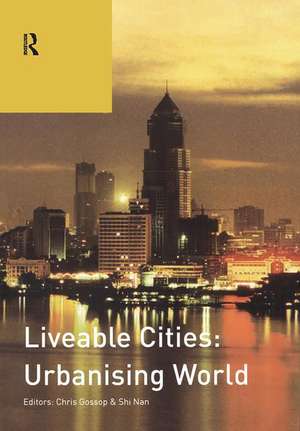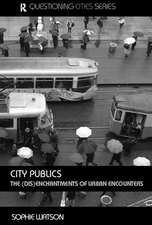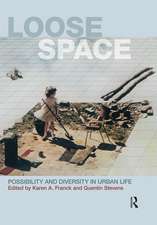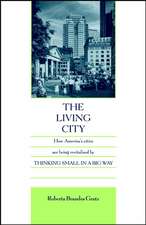Liveable Cities: Urbanising World: ISOCARP 07
Editat de Chris Gossop, Shi Nanen Limba Engleză Hardback – 30 sep 2020
| Toate formatele și edițiile | Preț | Express |
|---|---|---|
| Paperback (1) | 337.92 lei 6-8 săpt. | |
| Taylor & Francis – 13 mar 2012 | 337.92 lei 6-8 săpt. | |
| Hardback (1) | 995.46 lei 6-8 săpt. | |
| Taylor & Francis – 30 sep 2020 | 995.46 lei 6-8 săpt. |
Preț: 995.46 lei
Preț vechi: 1333.88 lei
-25% Nou
Puncte Express: 1493
Preț estimativ în valută:
190.48€ • 198.88$ • 157.65£
190.48€ • 198.88$ • 157.65£
Carte tipărită la comandă
Livrare economică 04-18 aprilie
Preluare comenzi: 021 569.72.76
Specificații
ISBN-13: 9781138469136
ISBN-10: 1138469130
Pagini: 336
Dimensiuni: 170 x 245 mm
Greutate: 0.93 kg
Ediția:1
Editura: Taylor & Francis
Colecția Routledge
Locul publicării:Oxford, United Kingdom
ISBN-10: 1138469130
Pagini: 336
Dimensiuni: 170 x 245 mm
Greutate: 0.93 kg
Ediția:1
Editura: Taylor & Francis
Colecția Routledge
Locul publicării:Oxford, United Kingdom
Public țintă
Professional and Professional Practice & DevelopmentCuprins
Foreword One/Ismael Fernandez Mejia -- Foreword Two/Qiu Baoxing -- Liveable Cities: Urbanising World An Introduction to the Review/Chris Gossop, Shi Nan -- PART 1 COUNTRIES AND CITY REGIONS -- Making Indian Cities Liveable: the Challenges of India’s Urban Transformation/Shipra Narang Suri -- The Urban Reform Agenda and the Struggle for Liveable Cities in Brazil/Edesio Fernandes -- The Netherlands in Transition -- The Planning of Low Carbon, Sustainable and Liveable Cities in the Utrecht Region/Martin Dubbeling -- Wikicity -- Open Planning for a Liveable Amsterdam 2004-2011/Zef Hemel -- PART 2 STUDIES AND STRATEGIES -- Beyond Cities: Is an Urban Planet even Possible?/Jeremy Dawkins -- Towards a Liveable Urban Climate: Lessons from Stuttgart/Michael Hebbert, Brian Webb -- Strategies for Integrated Spatial Development along the European North-South Railway Link/Bernd Scholl -- The Contribution of Mobility to Liveable Cities/Pierre Laconte -- Linking People, Linking Nature: The Park Connector Network of Singapore/Lena Chan, Cheng Hai Sim, Meng Tong Yeo, Kartini Omar-Hor -- Skolkovo: City of the Future as a Russian Hi-Tech Hub/Fedor Kudryavtsev, Victoria Bannykh -- The London 2012 Olympic Park: Planning for a Sustainable Legacy/Dan Epstein, Jo Carris, Emily Moore, Judith Sykes -- PART 3 CHINA REPORTS -- Planning the Ecological Spatial System of the Megacity of Wuhan/Liu Qizhi, He Mei, Wang Yun -- Local Governance of Low Carbon Cities: Is our Local Planning System Ready yet?/Stanley C. T. Yip -- Industrial Heritage as a Cultural Infrastructure/Dong Wei -- Devising an Adaptable Urban Shelter and Evacuation System in Disaster Situations/Su Jing-yu, Liu Chao-feng, Wang Wei -- A Study of Target Groups for Affordable Housing/Zhang Jie, Jiao Yang -- About the editors -- About the authors.
Descriere
Descriere de la o altă ediție sau format:
This book is about the unprecedented challenges facing the world’s cities as they expand and develop in response to demographic change, human aspirations and the forces of globalization. Most of that growth is taking place in the developing countries and it is here that the megacities (places with over ten million people) seem destined to emerge during the next few decades. While there are considerable variations in the rates of city expansion between and within the different world regions, much of that growth has taken place as formless urban sprawl, as well as the slums and squatter settlements to be found in many of the world’s cities.
These urbanizing areas face acute economic, social and environmental problems. So how can our cities become truly liveable places? Published in tandem with ISOCARP’s 47th World Congress held in Wuhan, China, the many case studies in this publication describe new planning and other approaches that seek to create more sustainable, more liveable, cities.
This book is about the unprecedented challenges facing the world’s cities as they expand and develop in response to demographic change, human aspirations and the forces of globalization. Most of that growth is taking place in the developing countries and it is here that the megacities (places with over ten million people) seem destined to emerge during the next few decades. While there are considerable variations in the rates of city expansion between and within the different world regions, much of that growth has taken place as formless urban sprawl, as well as the slums and squatter settlements to be found in many of the world’s cities.
These urbanizing areas face acute economic, social and environmental problems. So how can our cities become truly liveable places? Published in tandem with ISOCARP’s 47th World Congress held in Wuhan, China, the many case studies in this publication describe new planning and other approaches that seek to create more sustainable, more liveable, cities.















